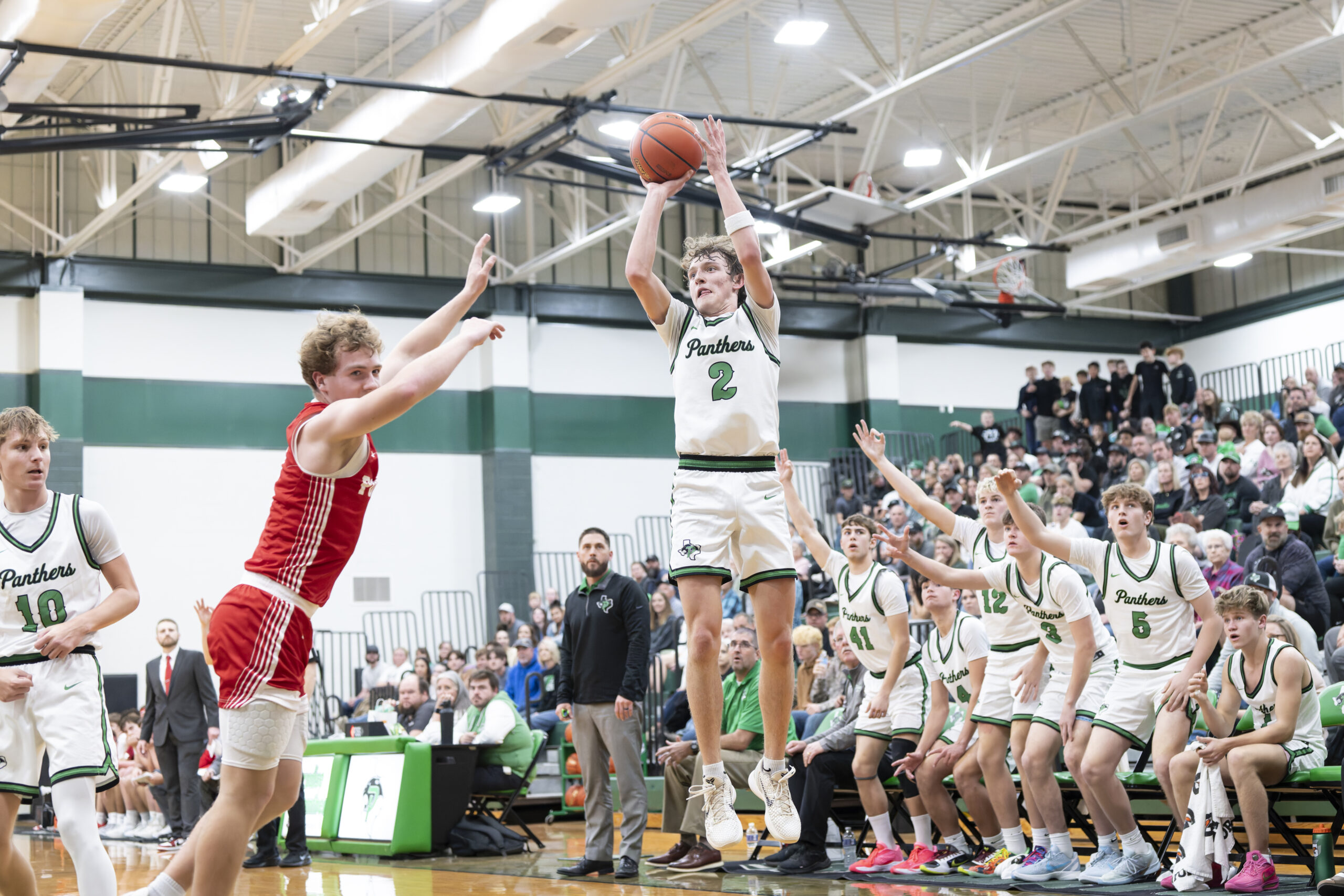Update
Panthers down Lions with hot night behind arc

Paradise guard Cooper Jones rises up for a 3-pointer in front of the Panther bench in the second half of the Panthers’ 48-31 District 10-3A win over Ponder Friday. MIKE HALL | WCMESSENGER
Limited to just three first-half points in the first District 10-3A home battle against Ponder Friday, Paradise junior guard Cooper Jones came out of halftime determined to get the fire of the Panthers’ offense burning after a cold first-half start.
“We were looking a little slow early on, and the score was a lot closer than it should have been,” Jones said. “I looked at the score and told myself, ‘That’s not what it should be. We’re a lot better than this team, and we can play like it. I need to take more shots.'”
The reigning All-Wise Offensive Player of the Year was the spark plug for the Panthers’ 31-18 second-half run, pouring in five of his six 3-points in the final 16 minutes to lead Paradise (21-2, 2-0) to a 48-31 victory.
Jones led the Panthers in scoring against the Lions with 21 points.
Ponder’s defensive pressure kept Jones quiet in the first quarter, holding the Panthers’ offense to just seven points — a pair of field goals by Bryce Chipman and a 3-pointer from Creek Gibson.
The Lions and Panthers remained evenly matched, but Jones’ lone basket in the first half fell through the net with 35 seconds left in the second quarter to give Paradise a 17-13 lead at halftime.
“The first half was like your typical, classic Paradise-Ponder game over the past couple of years,” Paradise coach Bo Rickner said. “It’s a defensive battle because we know each other so well, and we scout each other pretty good. We know what each other’s going to do at the offensive end, so it makes these games low-scoring affairs. I thought we had some good looks in the first half, but we kind of rushed things and didn’t get the offense enough time to work. We were taking quick shots. But for the most part, we were still getting open looks.”
Jones took the reins of the Panthers’ offense out of the break, as he went 1-of-2 at the free throw line and hit a 3-pointer in the first 2 minutes to force the Lions to burn a timeout. From there, the hot-shot guard continued to rise up, closing out the third frame with three additional baskets behind the arc to build up Paradise’s lead to 15, 36-21.
“Going into the second half, I decided to get my rhythm, and we really picked it up defensively,” Jones said. “When the shots finally started falling, I just stayed calm and kept shooting, and didn’t let the student section or people talking get to me — just play my game.”
Jones hit his final 3-pointer in the fourth quarter and added a pair of free throws, as Paradise picked up its second league win by outscoring Ponder 12-10 in the final 8 minutes.
Paradise’s deep-range shooting was effective in the win, as the Panthers bucketed a total of 10 3-pointers.
“[Shooting] can be contagious sometimes,” Rickner said. “It’s funny how that works — one guy gets hot, and everyone else thinks, ‘That looks good, I think I’ll try that, too.'”
The Panthers’ Will McGregor also bucketed a double-digit scoring performance, finishing with 12 points off three 3-pointers and a trio of foul shots.
Despite being outsized, the coach credited Paradise’s efforts on defense to shut down Ponder’s big-man duo of Kannon Clark and Henry Angeley, measuring 6-3 and 6-6, respectively. The pair of Lions were held to a combined seven points near the basket.
“It was great for our defense to show up tonight against [Ponder] the way it did,” Rickner said. In addition to [Clark] and [Angeley], they’ve got really good guards in [Blake Durham] and [Houstton Webster]. They didn’t score a whole lot tonight, and that’s a testament to Cash [Gibson], Creek and Bryce, and the kind of we play on the point. Will, Max [Jordan] and Wyatt [Sanders] did a good job guarding the big guys.”
Looking to bring home its second straight district title, Paradise — ranked second behind Dallas Madison in the Texas Association of Basketball Coaches 3A boys poll this week — travels to face Pilot Point Tuesday before hosting the first 10-3A Battle of Texas 114 rivalry matchup against Boyd Jan. 16. Both games are scheduled for 7:30 p.m.
“Anything’s possible for us this year,” Rickner said. “We could certainly go out there and lay some eggs and fall quite a ways, so we’ve got to be ready to play every night. Winning district is a goal these guys have set, but I know I’d give up a district title if it meant we get to go back to San Antonio this year. We’re hoping we can do both. It’s still all about positioning yourself for the postseason and going on a run in the playoffs.”


